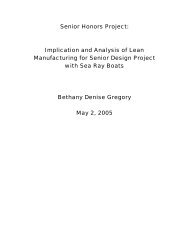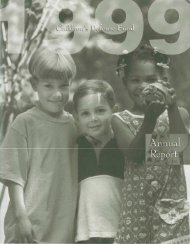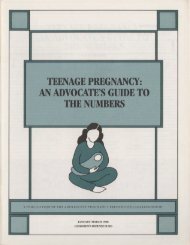child care - Digital Library Collections
child care - Digital Library Collections
child care - Digital Library Collections
You also want an ePaper? Increase the reach of your titles
YUMPU automatically turns print PDFs into web optimized ePapers that Google loves.
THE STATE OF AMERICA'S CHILDREN YEARBOOK 1998<br />
hardest hit. Their median income plunged 33 percent<br />
between 1973 and 1994, from nearly<br />
$30,000 to less than $20,000 (in 1994 dollars).<br />
Median income for families headed by a high<br />
school dropout likewise shriveled by close to onethird<br />
between 1973 and 1996, while that for families<br />
headed by a college graduate rose slightly.<br />
During the same period, income gaps between<br />
upper- and lower- income families widened (see<br />
figure 1.2). The poorest one-fifth of families (with<br />
or without <strong>child</strong>ren) in 1996 had incomes 9 percent<br />
lower than in 1973, while family income for<br />
the wealthiest fifth increased 35 percent. Families<br />
in the top 5 percent gained most; their incomes<br />
were 55 percent higher in 1996 than similar families<br />
two decades before.<br />
Minorities in particular have lost ground.<br />
While White families with <strong>child</strong>ren gained 4 percent<br />
from 1976 to 1996, Black families lost 4 percent<br />
and Hispanic families, 9 percent. Among<br />
young families the racial disparities in the income<br />
decline are especially wide, although minority<br />
households in every age group sustained losses.<br />
From 1973 to 1994, income dropped 46 percent<br />
among young Black families with <strong>child</strong>ren, com-<br />
pared with 28 percent among young Hispanics and<br />
22 percent among young Whites.<br />
Two-parent families would have lost far more if<br />
mothers had not increase~ their participation in<br />
the paid labor force. Between 1975 and 1994, married<br />
mothers ages 25 to 29 increased their average<br />
annual work time by more than 60 percent, according<br />
to CDF's calculations. Even so, young married<br />
couples with <strong>child</strong>ren typically had incomes 12<br />
percent lower in 1994 than in 1973 because the<br />
mother's additional work could not offset the 30<br />
percent decline in the father's earnings in the same<br />
period.<br />
The need for both parents to work in order to<br />
staunch the loss of wages has had far-reaching consequences<br />
for <strong>child</strong>ren. More money must be spent<br />
on <strong>child</strong> <strong>care</strong> and other job-related expenses. The<br />
availability of private health insurance through<br />
work has plummeted (see chapter 2), so working<br />
families with <strong>child</strong>ren must spend more out of<br />
pocket to meet their health <strong>care</strong> needs. These burdens<br />
are difficult enough for two-parent families<br />
but even more challenging for single parents. Their<br />
incomes are low; Census Bureau data reveal that in<br />
1996 nearly half (49 percent) of all <strong>child</strong>ren in<br />
Figure 1.1<br />
The Working Poor<br />
Work does not<br />
guarantee that families<br />
will escape poverty.<br />
A large and growing<br />
proportion of poor<br />
families with <strong>child</strong>ren<br />
are headed by<br />
someone who works.<br />
60<br />
58<br />
56<br />
54<br />
52<br />
50<br />
Percentage of poor families with <strong>child</strong>ren<br />
headed by someone who worked during the year<br />
Source: u.s. Deportment of Commerce, Bureau of the Census. Calculations by Children's<br />
Defense Fund.<br />
2 CHILDRE 'S DEFENSE FUND














